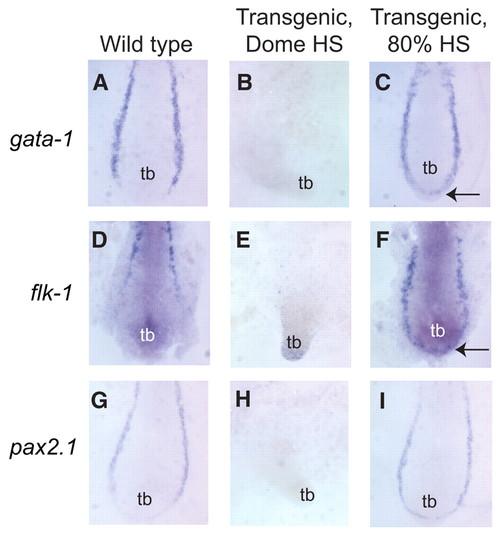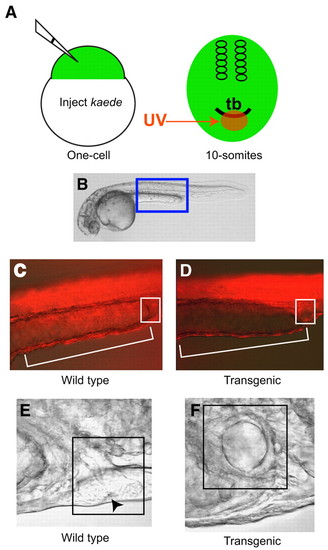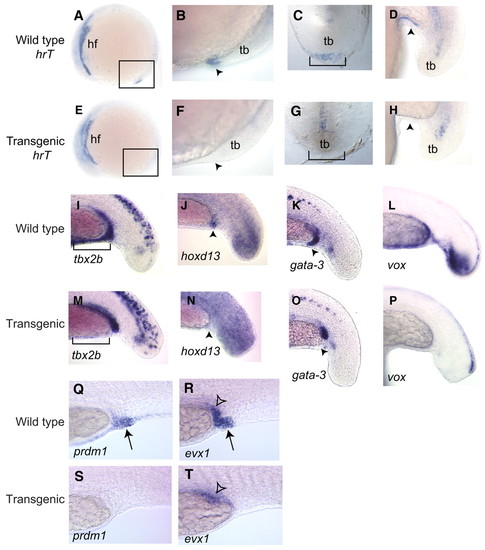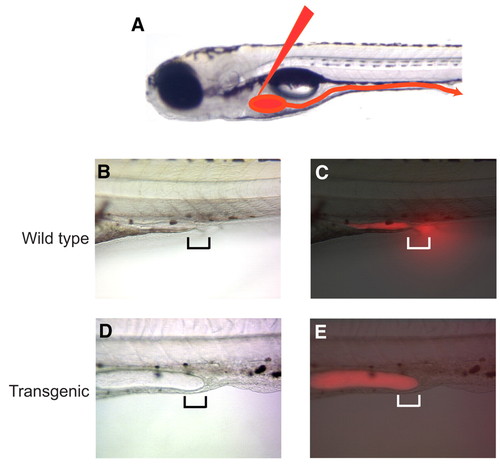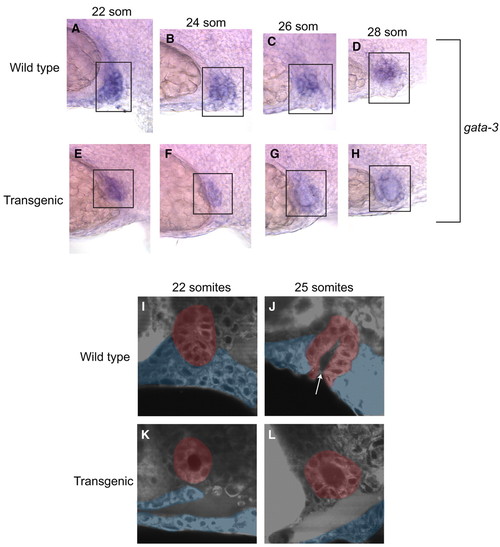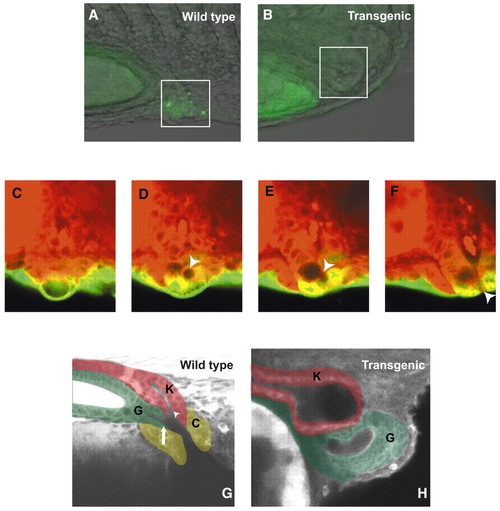- Title
-
Sustained Bmp signaling is essential for cloaca development in zebrafish
- Authors
- Pyati, U.J., Cooper, M.S., Davidson, A.J., Nechiporuk, A., and Kimelman, D.
- Source
- Full text @ Development
|
Reduction of Bmp signaling at the mid-gastrula stage causes expansion of blood and vascular cells into the extreme ventral mesoderm. (A-I) gata1 (A-C), flk1 (D-F), and pax2.1 (G-I) expression in heat-shocked wild-type and transgenic sibling embryos. Transgenic embryos heat shocked at dome stage have a loss or severe reduction in the expression of all three markers (B,E,H). Transgenic embryos heat shocked at 80% epiboly (mid-gastrula) have an expansion of gata1 and flk1 expression into the mesoderm below the tail bud (tb), marked by an arrow. All embryos are flat-mounted with anterior to the top, and images in A,D,G are representative of wild-type embryos from both stages of heat shock. EXPRESSION / LABELING:
|
|
Lineage labeling of cells ventral to the tail bud reveals severe deficiencies in ventral tissues of transgenic embryos. (A) Scheme for the lineage labeling of extreme ventral cells. (B) Illustration of the labeled region depicted in C and D. Note the decreased number of red fluorescent cells in the ventral yolk extension (bracketed) and cloacal (boxed) region in D compared with in C. (E,F) Visualization of 24 hpf embryos with Nomarski optics revealed severe defects in cloaca formation in transgenic embryos (F) compared with wild-type siblings (E). Arrowhead in (E) depicts the cloacal aperture, and boxed regions in (E) and (F) highlight the pronephric terminus. |
|
Reduced ventral gene expression in transgenic embryos. (A-C,E-G) 10-somite wild-type (A-C) and transgenic (E-G) embryos stained for hrT gene expression. A,B,E,F are lateral views; C,G are flat mounts. `hf' in A,E labels the heart-field expression of hrT, which is normal in transgenic embryos compared with wild-type siblings. The boxed region highlights the extreme ventral mesoderm, enlarged in B and F; arrowheads denote the ventral mesodermal domain. The bracketed regions in C and G show this same region in flat-mounted embryos. (D,H) 18-somite-stage wild-type (D) and transgenic (H) embryos stained for hrT expression. Arrowheads indicate the ventral mesodermal hrT expression. (I,M) 18-somite-stage embryos stained for tbx2b expression in wild-type (I) and transgenic (M) embryos. Brackets indicate extreme ventral tbx2b expression in the proctodeal and ventral yolk regions; this expression is absent in the transgenic embryos. (J,N) 18-somite stage embryos stained for hoxd13 in wild-type (J) and transgenic (N) embryos. Arrowheads indicate the proctodeal region, where hoxd13 expression is absent in transgenics compared with wild-type siblings. Note that the posterior expression of hoxd13 expands anteriorly in the transgenic embryos. (K,O) gata3 expression in wild-type (K) and transgenic (O) embryos. Arrowheads indicate the ventral limit of the normal pronephric terminus. (L,P) vox expression in wild-type (L) and transgenic (P) embryos. Note the loss of ventral expression in transgenic embryos compared with wild-type siblings. (Q-T) prdm1 (Q,S) and evx1 (R,T) expression in wild-type and transgenic embryos at 24 hpf. Note the loss of prdm1 expression in the epidermis and cloaca of transgenic embryos. evx1 expression is absent in the cloaca of transgenic embryos, but it is retained in the posterior gut and posterior kidney tissues. Arrows in Q and R mark the cloacal domain of prdm1 and evx1 expression, respectively, and arrowheads in R and T mark the posterior gut and kidney expression of evx1. EXPRESSION / LABELING:
|
|
Transgenic embryos do not develop a functional cloaca. (A) Overview of the rhodamine gut injection assay used to assess cloacal function in wild-type and transgenic embryos. (B,C) Injected wild-type embryos secrete the rhodamine dextran from their cloaca within minutes. (D,E) Transgenic embryos develop a buildup of rhodamine dextran at the end of their gut, and they do not excrete the dye into the media. B,D are brightfield views; C,E are brightfield/fluorescent merged images. Brackets in B-E indicate the gut terminus. |
|
Manifestation of defects in the presumptive cloaca of transgenic embryos. (A-H) gata3 expression in the kidney terminus of wild-type (A-D) and transgenic (E-H) sibling embryos at the 22-28 somite (som) stages. Note the lack of remodeling in the transgenic embryos compared with wild types (the wild-type cloacal opening is obscured in these images as a result of the fixation and subsequent processing). (I-L) Wild-type and transgenic sibling embryos heat shocked at 80% epiboly were stained with BODIPY TR methyl ester and imaged with a confocal microscope. Pseudocoloring was used to highlight the kidney terminus in red and the proctodeum and epidermis in blue. (I,K) The kidney terminus in 22-somite wild-type embryos (I) has reached the ventral limit of the tail, while it has not in transgenic siblings (K). (J,L) At 25 somites, the kidney terminus opens to the exterior in some wild type fish (J), while the kidney has swelled up in transgenic siblings (L). EXPRESSION / LABELING:
PHENOTYPE:
|
|
Visualizing cloaca development in living embryos. (A,B) Acridine Orange staining in wild-type and transgenic embryos to assay cell death in the developing cloaca region. The posterior kidney region is boxed. (C-F) Detailed time lapse of an msxb-gfp embryo during opening of the presumptive cloaca. Note initially the kidney terminus, cup-shaped proctodeum, and epidermis (green; C) at 24-somites. A single vacuolated proctodeal cell (arrowhead in D-F) emerges and migrates to the ventral limit of the epidermis, where it forms a pore (F). At that point, the kidney terminus has connected to the epidermis and there is a continuous opening to the outside of the embryo (see also Movie 1 in the supplementary material for the full time lapse). (G,H) Excretory region of a wild-type and transgenic sibling larva, respectively, at 4 dpf. Regions of the excretory system have been pseudo-colored for identification: K, kidney (red); G, gut (green); C, cloaca (yellow). Arrowhead in G marks the kidney (urogenital) opening, and arrow marks the gut opening. |
|
hrT morphants have defects in cloaca development. (A,B) Compared with mismatch (mm) control morphants (A), hrT morphant embryos (B) develop dysmorphic cloacas. Embryos were photographed at 48 hpf. Arrow indicates the region where the cloacal opening normally develops. (C-H) Expression of (C,D) tbx2b, (E,F) hoxd13 and (G,H) gata3 in mismatch control morphants (C,E,G) and hrT morphants (D,F,H) at 18 hpf (C-F) or 20 hpf (G,H). Note the normal expression of these three genes in hrT morphant embryos. Arrowheads mark the proctodeal region in C-H. PHENOTYPE:
|

